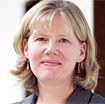Commentary on Luke 13:10-17
She had gotten used to looking at people out of the corner of her eye, by looking up and sideways.
After eighteen years, she could hardly remember any other way of seeing the world. On this particular Sabbath, there was a special excitement at the synagogue, where she regularly went to worship. A Galilean preacher and prophet, Jesus of Nazareth, had arrived in town and would be teaching there. She and the others in town had heard reports about Jesus–how he talked about God’s reign arriving soon and how he healed sick people. She was not sure how many of the rumors to believe, but she was trying not to get her hopes up. Her life already had too many disappointments to count.
When she entered the synagogue, the place was abuzz. As Jesus began to teach, however, the room was hushed. Moments later, his words turned from teaching to invitation. He had caught her eye–no mean feat, given that he had to lean over and incline his head to do so. “Come here,” he said to her. She slowly made her way to the front of the assembly.
What happened next amazed the whole congregation. “Woman, you are set free from your ailment.” When this man, Jesus, spoke those words and put his hands on her broken, bent body, she felt power surge through her. Without hesitation, she straightened her once crooked back. She stood tall and praised her God . . .
~~~~~
While the point of view of the biblical author is the most prominent perspective in a text, imaginatively exploring the experiences of one or more characters can raise helpful interpretive questions and contextual insights. Reading from the perspective of the bent over woman in Luke 13:10-17 is one such example.
A reading from this perspective emphasizes the healing as the crucial starting point of the story. While this pericope is a story of controversy between Jesus and the synagogue leader, at its core is a healing that demonstrates Jesus’ power and his compassion. We hear the compassionate tone in Jesus’ defense for healing on the Sabbath when he argues from lesser to greater: if compassion is shown to one’s animals on the Sabbath by providing them water, “ought not this woman, a daughter of Abraham whom Satan bound for eighteen long years, be set free from this bondage on the Sabbath day?” (13:16). Although Luke has not provided this woman with a name in the story, he indicates that Jesus gives her a “name,” the daughter of Abraham. This phrase does not occur elsewhere in Luke or in the rest of Scripture (cf. Luke 19:9, where Jesus calls Zacchaeus “a son of Abraham”). This name stresses the woman’s membership in the covenant community.
Another value of reading imaginatively from the woman’s perspective is the raising of historical questions about her relationship to her (Jewish) faith and community. There is a tendency to read the gospels in ways that denigrate first-century Judaism and highlight Jesus over against his Jewish context.
We could do this rather easily with this passage by making the synagogue leader simply the “bad guy” (13:14), without any exploration of why he interprets Sabbath laws as he does. Such a reading of the passage and of Luke more broadly may be common enough; but it does not cohere well with the more nuanced understandings of Judaism that have been offered in recent years in NT scholarship. According to the passage, Jesus offers the woman healing, not salvation from an oppressive socio-religious system. In all likelihood, the woman was cared for by her Jewish community of faith, the synagogue of which she was a part (she is there, after all!). Exploring the story from her perspective emphasizes the way her healing extends the kingdom of God as announced and embodied by Jesus’ ministry in Luke.
The shape of Jesus’ ministry is expressed by Luke when Jesus reads from Isaiah 58 and 61 (Luke 4:18-19) and then claims, “Today this scripture is fulfilled in your hearing” (4:21). The freedom announced in Isaiah is actualized throughout Jesus’ kingdom ministry and certainly in this woman’s freedom from her physical bondage.
What do we make, then, of the controversy between Jesus and the synagogue leader who objects to this Sabbath healing? It might be a helpful homiletical move to tell the story from the latter’s perspective to heighten our awareness of questions of historical setting. Here we might note a couple of things. First, the synagogue leader’s complaint is, on the surface, a faithful reading of the Torah: the seventh day was set aside by God for Israel’s rest, and work was prohibited on the Sabbath (e.g., Exodus 31:14). Second, Jesus’ response is not a rejection of the Torah rulings about the Sabbath. Instead, he argues from legitimate allowances of restricted kinds of “work” on the Sabbath (13:15). These kinds of discussions were common in Jewish dialogue regarding the Sabbath. Then Jesus argues for healing on the Sabbath based on the great worth of the woman as “a daughter of Abraham” and the appropriateness of healing on the Sabbath. What better day to heal (bring freedom) than on the Sabbath?
Jesus’ perspective on the Sabbath as a day for deliverance is vindicated, as Luke narrates the humiliation of Jesus’ opponents and the joy of the crowds at his wonderful (healing) deeds (13:17). Although we do not hear about the woman who has been healed at the end of the passage, the praise she offers to God (doxazo; 13:13) reverberates with the crowds’ rejoicing (chairo; 13:17). Both themes of praise and rejoicing are emphasized by Luke as appropriate responses to God’s work in Jesus (e.g., 7:16) the one who brings the reign of God in healing power to those who most need it.

August 22, 2010